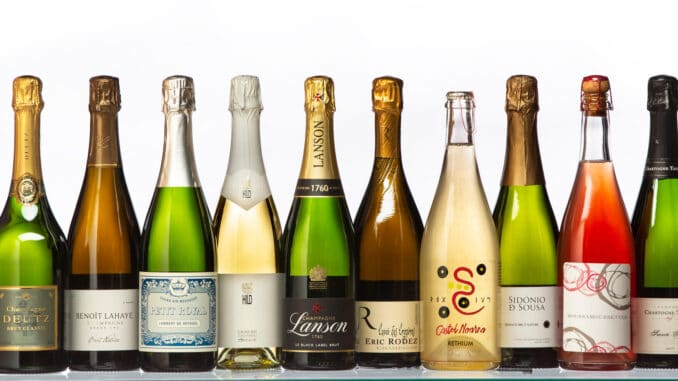
Not everything that sparkles comes from the Champagne area. The rest (a little less than 2 billion bottles, worldwide on a yearly base) may not be called Champagne even if it is produced using exactly the same grapes and exactly the same production methods.

That Champagne can only be called Champagne if produced in the Champagne area stems from a bunch of French laws from 1914, 1918, 1927 and 1936. To top that, according to the same laws even the name “Methode Champenoise” is restricted to the producers from the Champagne area. Officially French laws cannot be applied outside France but in order to stay on friendly terms with the French, all member states of the EEC kindly and pragmatically accepted the French legislation. When the French wanted to confiscate the nameplates of the Swiss village of “Champagne” that carried this name for more than a thousand years, the Swiss told the French loud and clear: “that there are limits”.
Many other countries also gave in to the heavy pressure of France. In South Africa you’ll hardly encounter the name of Champagne. Nowadays the stuff is called “Methode Cap Classique”(grapes and process are for a 100% similar to the process used in making Champagne, only the soil and the climate are somewhat different. The further you roam from France the more bottles you will see with the word Champagne printed on the label. In my opinion Argentine, Brazil, Australia and New Zealand cannot be seriously bothered with the French rules of the game. The South Americans call their local brew: Champaña (read Champanja).
For producing sparkling wines, most of the time a different production process is used than for manufacturing Champagne.
With the methode traditionel (just as with the methode champenoise) fermentation of the grape juices takes place in two phases. The first fermentation in the vat and the second in the bottle. Because of the fact that the second fermentation produces carbonic acid that cannot escape from the bottle this carbonic acid will dissolve in the grape juice and thus will turn into a sparkling wine.
With wines that are made according to the “transvasage” method” the second fermentation also happens in the bottle, but after that the stuff is poured in a vat, will be filtered and bottled once again. This method will of course cause some loss of carbon dioxide (CO2).
With the “cuve close” (or the tank method) the first as well as the second fermentation occurs in the vat. This is not necessarily a wrong procedure as long as the tank stays properly closed during the second fermentation.
Actually this method is mostly used to make cheaper sparkling wines.
Read more in the book “101 Champagnes and other Sparkling Wines: To Try Before You Die“
If the wine is subject to only one fermentation process as opposed to two different ones one speaks of the “methode ancestrale”. This method is, amongst others ,used for making French bubbles from the Limoux region.
The most abject method for making a sparkling wine is by injecting CO2 inn a still wine, like making Coca Cola so to speak.
Contrary to what many a Champagne specialist maintains the bubbles in a carbonated wine nowadays are not necessarily bigger than those in Champagne. The method is often used in South Africa and Australia. The stuff costs less than 2 Euro the bottle in those countries.
Sparkling wines are often named after the region they come from while the same type indications are used as for Champagne (Brut, Rosé etc). There are also many sparkling wines that are made of white grapes (mainly Chardonney) and are also called Blanc –de- Blancs although they are not Champagnes.
When paying the more expensive price of Champagne you want to be sure that you really get Champagne. The only way to find out is to look for the word Champagne on the label. It so happens that that is compulsory for wines from the Champagne region but prohibited for wines from outside of the area.
Here under you’ll find a survey of how the bubbly stuff is called nowadays.
• Cava; White Spanish sparkling wine
• Champagña White South American sparkling wine often “methode traditionel”
• Champanski; White Russian sparkling wine, often very sweet
• Crémant; French (non Champagne) sparkling wine from amongst others Alsace
• Espumante; Portuguese sparkling wine 9more than 3,5 bar pressure in the bottle)
• Espumoso; Spanish sparkling wine (more than 3,5 bar pressure in the bottle)
• Frizzantino; Italian light sparkling wine
• Methode Cap Classique; Sparkling white wine from South Africa (also known as Vonkelwijn)
• Methode Traditionel; Sparkling white wine, not from the Champagne Ardennes
• Perlé; French light sparkling wine (less than 2,5 bar pressure in the bottle)
• Perlwein; German light sparkling wine (less than 2,5 bar pressure in the bottle)
• Prickle; English light sparkling wine (less than 2,5 bar pressure in the bottle)
• Saumur; French (non Champagne) sparkling wine from Saumur.
• Sekt; white German sparkling wine (more than 3,5 bar pressure in the bottle)
• Semi-sparkling; English light sparkling wine (between 2,5 and 3,5 bar pressure in the bottle)
• Sparkling; English/Australian sparkling wine (more than 3,5 bar pressure in the bottle)
• Sparkling Red; Sparkling red wine not from the Champagne region (mostly from Australia)
• Spritzig; German light sparkling wine (between 2.5.and 3.5 bar pressure in the bottle.
• Spumante; Italian sparkling wine (more than 3,5 bar pressure in the bottle)
• Vino de Aguja; Spanish light sparkling wine (less than 2,5 bar pressure in the bottle)
• Vouvray; French (non Champagne) sparkling wine from Vouvray.
